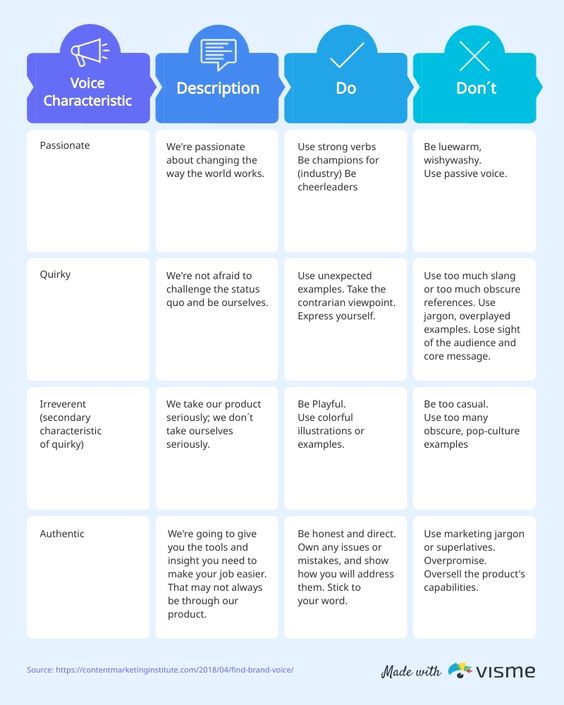Introduction
Your brand voice is more than just the words you employ; it’s the personality, tone, and style that reflect who you are as a company. A strong, consistent brand voice enables you to connect with your audience, develop trust, and differentiate your business in a crowded market. In this piece, we’ll look at how to create a brand voice that speaks to your target audience while still reflecting your distinct individuality.
1. Understand Your Audience
In developing a brand voice, you need to understand who you’re speaking to. Audience research is key to gaining insights into the demographics, preferences, values, and challenges of your target market. Start by creating buyer personas—fictional representations of your ideal customers. These personas should include details like age, occupation, interests, and pain points.
Understanding your audience allows you to tailor your brand voice to speak directly to their needs and desires. For example, if your audience is primarily young professionals, your voice might be energetic and forward-thinking. On the other hand, if you’re targeting a more traditional audience, your tone might be formal and reassuring.
2. Define Your Brand’s Personality
Your brand’s personality is the foundation of your voice. It’s the set of human characteristics associated with your brand, shaping how you communicate with your audience. To define your brand’s personality, consider what makes your brand unique. Are you innovative and cutting-edge, or reliable and trustworthy?
One effective method is to use a brand personality framework, such as the “Big Five” personality traits—Sincerity, Excitement, Competence, Sophistication, and Ruggedness. Choose the traits that align most closely with your brand and use them as a guide to shape your voice.
For instance, a brand with a “Sophisticated” personality might use elegant, refined language, while a brand with an “Exciting” personality could opt for lively, informal language.
See HubSpot for more on defining brand personality.

3. Create a Brand Voice Chart
A brand voice chart is a practical tool that outlines how your brand should sound across different scenarios and platforms. This chart should include your brand’s core attributes, along with specific guidelines for tone and style in various contexts, such as social media, emails, website copy, and customer service interactions.
For each platform, list out examples of do’s and don’ts to ensure consistency. For instance, if your brand voice is friendly and approachable, your social media posts might include casual language and emojis, while your emails might be slightly more formal but still warm and personable.
This chart serves as a reference for anyone who writes on behalf of your brand, ensuring that your voice remains consistent across all channels.

4. Align Your Voice with Your Brand Values
Your brand voice should be a reflection of your core values and mission. If sustainability is a key value, your voice should naturally incorporate messaging that emphasizes eco-friendliness and responsibility. If innovation is at the heart of your brand, your voice might be bold, forward-thinking, and focused on the future.
To align your voice with your values, first, identify the core values that define your brand. Then, consider how these values translate into the language you use. For example, a brand that values community might use inclusive language that fosters a sense of belonging.
Ensuring that your voice reflects your values helps build authenticity and trust with your audience, as they can see that your brand’s messaging is consistent with its actions and ethos.
Check out Hypeverve’s Blog post on Defining Brand Values: A Comprehensive Guide to Building a Strong, Authentic Brand for more insight.
5. Test and Refine Your Voice
Developing a brand voice is not a one-time task. As your business evolves, so too should your brand voice. Regularly testing and refining your voice ensures that it stays relevant and resonates with your audience. Start by reviewing feedback from customers and monitoring engagement metrics on your content to see how your audience responds to your voice.
Conduct A/B testing on different pieces of content to determine which tone, style, or language resonates most with your audience. This data-driven approach will help you fine-tune your voice and make necessary adjustments.
Additionally, stay attuned to changes in your industry and audience preferences. If your audience is shifting towards a more casual, informal tone, consider adapting your voice accordingly.
Conclusion
Developing a brand voice is a crucial step in building a strong, recognizable brand. By understanding your audience, defining your brand’s personality, creating a voice chart, aligning with your values, testing and refining your voice, and documenting your guidelines, you can create a consistent and authentic brand presence that truly resonates with your audience.
Remember, your brand voice is not static—it should evolve with your brand and adapt to the changing needs of your audience.
Start building your brand voice today, and watch how it strengthens your connection with your customers.






